Index: The Artists of spirit - The Books of Stone – The “Stones that sound” – Poseidon's Temple - The hermetic Cloister of the Monastery of San Cugat in Vallès - Cosmogony of the Number 72 – Astronomy and the Work of the Great Builders – Appendix: Alexandria's Library, beacon of wisdom between East and West
«Art can express spirituality, but spirituality can't find its expression in prosaic cults»
The Artists of spirit
The work of art is the symbol of the artist; the sacred Work is the symbol of great Builders.
Among the great works, perhaps architecture is the Art which has best represented sacredness; it has built spaces where purity of forms has inspired thinkers, artists and ordinary people.
In every era and people, creative geniuses have enlightened the weak thoughts of material cultures. Artists of spirit have shown the sacred fire that fed them, causing people's admiration. Sacredness inspires admiration and generates spiritual feelings. But it would be a mistake to attribute the birth of spiritual feeling to objects or forms, which are only man's products and artifacts. Indeed, when a book, a symbol, a statue or any other material product becomes object of cult we have a manifestation of idolatry. Sacredness, then, is not its representation, but the inspiration that guided its creator. Only through this distinction we can access the secrets of the sacred work.
The idea that a harmonious space (dimension, space and conscience) can express spiritual afflatus comes from Pythagoras, who was initiated in Alexandria (see Library of Alexandria in appendix). Plato talks about the relations of the universe as the "sound of spheres" (celestial). In its tables, Fludd uses sonorous standards to describe the relations between planetary Logos and the solar system.
Mathematical and sonorous principles, criteria of perspective in art and architecture, chromatic scales, colors, sounds, surfaces and spaces all obey the rules of Harmonics. This regards anyone who wants to appreciate the creative genius of great Builders , driven by intuition and inspiration (see Analysis of creative fever), and concretized by method.
Intuition shows the idea, whilst method creates the right relations between idea and form used to represent it. The main aspects of representations are their volumes, which are the subjects of the science called "Harmonics". It starts from the assumption that "harmony dissolves chaos", tempering every phenomenon, just like the tempered scale tunes sound through the 7 notes (C, D, E, F, G, A, B).
The Books of Stone
In a strict sense Ars Muratoria doesn't reflect the secrets of the art of workers, but rather those of the designers. The "strong thought" of Ars Muratoria is in the principles of sacred architecture rather than in the morality of its workers. The great Books of Stone are the keys to the less accessible "arcana". Therefore it is not a lack of respect to distinguish between the tradition of people working with their hands and people working with their brains. Nevertheless, in order to explain the initiatory profile of the speculative Worker, it is necessary to distinguish between religiosity and spirituality, between popular soul and elitist spirit.
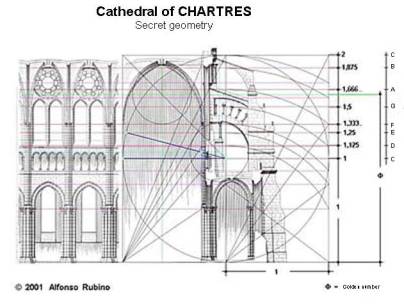
The Builders of the Temples were Initiates who, with sacrum facere, created geometries that could reproduce divine ideas in stone. In the East and in the West Buildings that showed God's goals were created. In order for the Secret Doctrine not to be abused, the outlines of the Great Work were re-veiled (veiled twice) in "Beauty". Geometries, monograms, decorative signs and vestments hid the Mysteries of the Ars Muratoria making them invisible to the eyes of the "non-introduced".
Careless of time and space, the great Books of Stone keep reflecting the light of wisdom of ancient Hierophants.*
__________
* Hierophants (from which the terms hieratic and hieroinspiration are derived) didn't encourage contacts with people who spread exoteric criteria by amplifying popular beliefs. They didn't follow exterior cults destined to the people, but rather an over-mundane spirituality, which expressed a light that descended from the inner sky. Hierophants were pontiffs and initiators of principles which were invisible and therefore considered secret. They were connected to the invisible sky (the plane of divine conscience) reaching a very high ritual and theurgic condition. Their prerogative was to reach assonance among gestures, sounds and words . The most sacred act was the consecration of the living matter ; the supreme ritual that concluded it consisted of inflaming the "inner land" of the initiate. To the ordinary eyes, this made the initiate a demigod, a messenger of God. This is how the belief that Gods walked among men arouse.
__________
The “Stones that sound”
Inner spaces determined the style of architecture. This is a very interesting detail, because it leads us to understand the relation between space, sound and spiritual dimension. This makes the "subtle relation" between sacred representation and spiritual dimension visible; this reveals the highest apex of Ars Muratoria. We will gradually get closer to this concept, starting from the postulate of an ancient Commentary:
«The harmony among number, geometry and spirituality gives sacredness to a construction aimed at representing the golden relation between Man and God. This knowledge belongs to an elitist group aware that sacred constructions are Architectonic Tables carved for the future generations of initiates» .
To resume elitist meanings is not easy, but images are worth more than words, therefore we will use their silent eloquence to provide good examples of building excellence.
In the first image the harmonious relations of Man are represented (sound-number-dimension-space). It is a science born with Pythagoras with the help of the famous Monochord that he invented (see Harmonics and Akroasis).
In the following image we can see the development of the correspondences between Man's dimension and the dimensions of sacred Architecture.
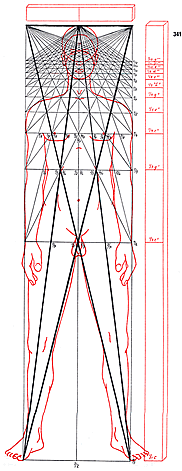
|
«Egyptian, romanic, gothic. In the first the earth prevails, in the second a balance is reached; in the third this balance is overcome to the advantage of the celestial element. Three octaves, three styles, three civilizations». |
|
The subject is studied further in «Sonorous images» (see).
An essay on sonorous geometry extracted from the Books of Harmonics (Lehrbuck der Harmonik, by Hans Kaiser, Science Museum of Geneva).
Nowadays the laws of Harmonics are also physics of sound; as far as the dimension of mind and conscience are concerned, the study has become psycho-acoustics.
By acting with the right (number) tonality (sound) we can activate certain physical-mental points, to which the conscience reacts, in order to develop sensations, emotions and feelings that strengthen intuition and refine mental potentialities.
Scientific tests have demonstrated that by directing two opposite tonalities (sinusoidal sound) through the ears, the different perceptivities of the two cerebral lobes (see masculine and feminine) join together "geometrizing themselves in the shape of a rhombus" at the center of the brain. This process of concentration brings a spontaneous form of mental synthesis, a "perceptive unison" absolutely similar to that of the spiritual perceivers. It is obvious the value of this study in every aspect.
The art of building artifacts and to compose symbols that could represent the relation between physicality and spiritual dimension between Man and divine Plane was shared by all great Builders, which in the contact between heaven and earth wanted to indicate the overcoming of material limits.
These lessons of Ars Muratoria have never been highlighted in the rooms of Freemasonry, despite it being the heir of the great Builders. We don't know why, perhaps it doesn't consider its workers ready for it.
Poseidon's Temple
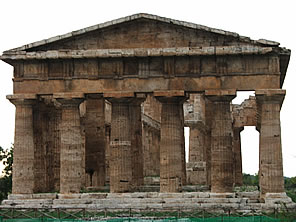
|
It would be limitative to consider medieval buildings as the only examples of building excellence. To build Temples according to the laws of Harmonics is an ancient cognition, in the East as well as in the West. The Temple of Poseidon (Neptune) erected in the ancient Paestum is an example of it. We give its architectonic and harmonic analysis below.
Poseidon's Temple is a perfect example of Doric style. It is harmonious and eurhythmic; it includes a peripteral building of 24.14 m x 59.88m with 6 by 14 pillars. The dimension of the bigger pillars (8.89m tall) gives height to the building, whilst the smaller intercolumniation is 2.43m. The ambulacrum of 3.30 m separates the pillars from the naos, which has three aisles defined by two rows of six smaller pillars; the central aisle is the biggest. |
«The dimensions harmoniously interpreted according to the base Principle in the Monochord of Pythagoras have been conceived so that a melody can be reproduced with a piano. The separations show in the most suitable form the proportions on the frontal part of the Temple, divided into four main parts. The three missing parts in the representation above the length of the Temple and in first and second order of pillars inside it are present and shown, in the image of the Monochord that contains all the main forms.
|
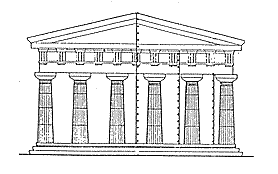
|
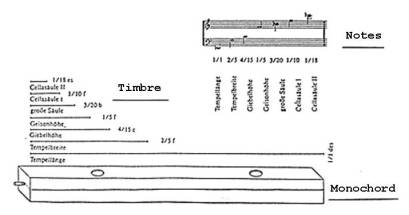
|
As a 1/1 unit of the chord it has been used the length of the Temple plus the size of the relation of the remaining Forms which, with their length of chord and its relations are horizontally visible, above the Monochord. Sounds and notes, according to our method of measure, are situated on the side».
|
The hermetic Cloister of the Monastery of San Cugat in Vallès
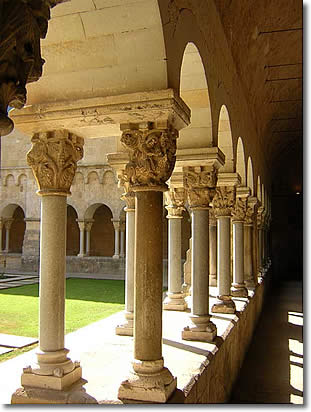
|
Besides Greek and Roman sacred buildings, there are others based on hermetic-musical notations, such as the cloisters of the Monasery of San Cugat in Vallès, in Catalonia, studied by Marius Schneider ["Pietre che cantano" ( "Stones that sing", Note of the Translator ) 1980, Guanda Ed.].
They mainly represent animals. Schneider has found the correspondence among the animals that ornate the capitals, musical notes, the hours of the day and equinoctial and solstitial events.
What looks like simple decorations are in actual fact precise musical notations, which must be read keeping in mind many other elements (the dimensions of the church, the number of pillars, and their orientation). By decoding the complex code some melodies have been reconstructed; they are the musical heart of the Cloister that accompanied particular liturgical rites. |
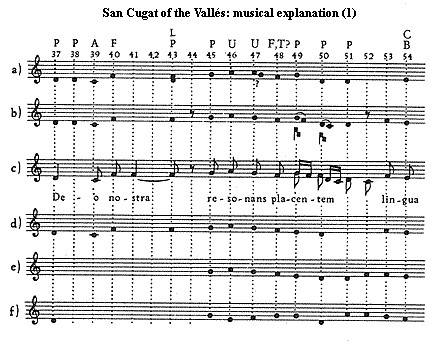
The Cloister was built by the artist Arnau Gatell; it is 30 meters long. It is a squre surrounded by arches supported by 72 pairs of columns, decorated with capitals finely ornated with animals and biblical scenes. The building around it has a gothic style and is 52m x 23m, with a rose window whose diameter is 8.2m.
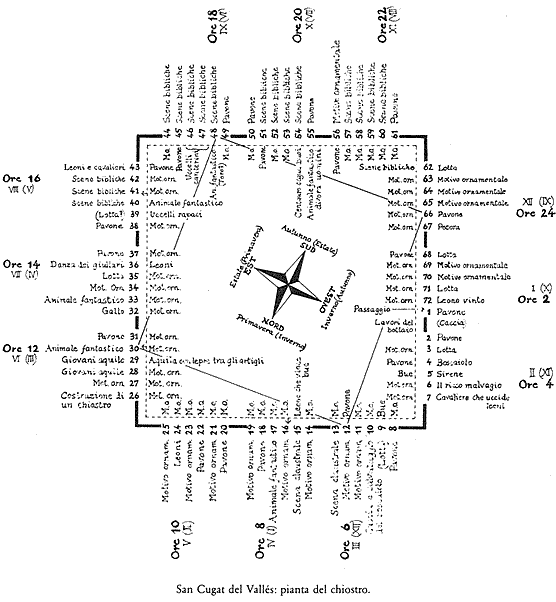
Cosmogony of the Number 72
The meaning of the 72 capitals in the cloister is important.
In ancient times this number was recurring in many buildings, represented in the form of sacred iconographic representations. This Number is linked to the equinoctial precession. Every 72 years the stars rotate of a degree in relation to the horizon; in 25,920 years they complete a cycle of the Zodiac or, as it has been called, a "Great Year".
72 is a precessional number that is found in the ladder dreamed of by Jacob, made by seventy-two steps.
Astronomy and the Work of the Great Builders
The characteristic of the Builders expressed as Art, Beauty and Harmony, was based on steady scientific theories; it would be wrong not to recognize this aspect.
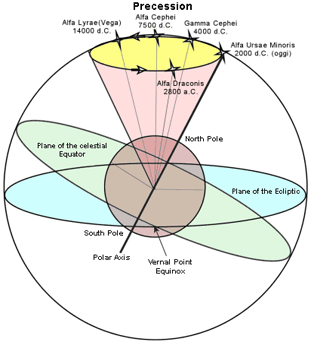
|
In a world affected by ignorance and superstition, their scientific notions prevented them from being influenced by them. We have mentioned harmonics of space; we need to add precise astronomical knowledge. The demonstration is that they knew about planetary precession and used it to orient sacred buildings. The knowledge of «starry Vault» still impressed in the masonic Temples was not astrology, but science of the stars. We have chosen the example of a phenomenon that will demonstrated it undeniably.
The rotation axis of the earth is not still but it moves in space describing a cone around the plane of the ecliptic. This motion is called precession, it lasts 25,700 years which are used in the counting of the Eras. As a consequence to this motion, the position of the celestial poles moves of 50 degrees every year. This leads us to the position of the star closer to the celestial North pole, which is now Ursa Minor, therefore identified as polar star. |
Because of this movement the planes of the equator and of the ecliptic move in the direction opposite to the apparent motion of the Sun; this motion is the precession of the equinoxes which, together with solstices, are the basis of mysterial rituals.
Men built zodiacs and eras by following celestial motions. The vernal equinox that 3,000 years ago was in the constellation of Taurus, today is in the constellation of Pisces and in a few hundred years it will be in Aquarius. All this and much more has been written in the "Stones" by the great Builders; this is a drive to study further and further the "reading" of the masonry tradition. 
__________
Appendix
Alexandria's Library, beacon of wisdom between East and West
Alexandria was founded by Alexander the Great in 332 B.C. After his death, the Kingdom of Egypt went to the Macedonian Ptolemaic dynasty. Under their government Alexandria became the commercial capital as well as the political capital of Egypt.
So much so that Ptolomy I erected an enormous Lighthouse to prevent accidents for the ships directed to its port.
He also erected a building to contain the big library called "Bruchium" (place of the lymph of knowledge). Pharaoh Ptolomy I was driven by love for knowledge; he sent his emissaries to gather any important document. He enacted an edict that started a gathering called "fund of the ships"; it consisted of acquiring all the books found on the ships anchored in the port of Alexandria. |
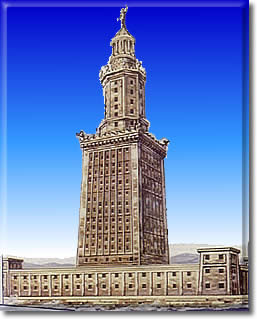
|
By edict of the pharaoh the books had to be left in the Library; a copy was given back to the owners. This is how the translation in Greek of the Old Testament was produced; it was the famous Septuagint or "Bible of the Seventy".
The first director was Zenodotus of Ephesus, author of the critical essay on Homer's poems. He put the scrolls of the library in alphabetical order. The first catalogue is due to Callimachus of Cyrene, whose main work was Pinakes or Tablets of the eminent people in every branch of knowledge, with the list of their works , which provided the list for the catalogue of the royal library.
After the direction of Apollonius of Rhodes, in the second half of the 3rd century B.C. the great geographer Eratosthenes managed the library; he helped increasing the number of scientific works.
Eratosthenes, "professor" of mathematics and geography, managed to measure the circumference of the Earth. He wrote about philosophy, theater and poetry. He drew the first complete geographic map of the world. He was positive about the sphericity of the earth and he supported the possibility of reaching Spain from India sailing towards west.
The Library reached its highest point with Aristophanes of Byzantium and his disciple Aristarchus of Samothrace; it reached the number of seven hundred thousand scrolls of papyrus from all over the known world.
The volumes were placed in alcoves in the wall and they contained the knowledge of a whole civilization. The example was followed by Ptolomy II; under his government Alexandria of Egypt became the biggest and most flourishing city in the ancient world. It was the cradle of Methodology (Euclid), astronomy (Aristarchus of Samos), geographical cartography (Eratosthenes) and medicine of the nervous and circulatory systems (Herophilos, Erasistratus).
The end of the library is mysterious. Some historians say that it was accidentally burnt by Julius Caesar; when he burnt Cleopatra's fleet the flames spread to the neighbor buildings burning it. Most of the scholars, though, attribute the disappearance of the Library to the patriarch of Alexandria Theophilus, who led a crowd of fanatics to the total destruction of a symbol which, for Christians, represented the knowledge of the pagan world.
In this episode we have the image of Hypatia, an educated and intelligent woman, a philosopher and a free thinker, daughter of Theon, a mathematician and last keeper of the Library. She was dragged off a cart by a crowd of fanatics and burnt alive in the Library like a witch, before they burnt down the Library itself. This was a well devised plan to destroy all the books that scared religious ignorance. (back to the main article)
